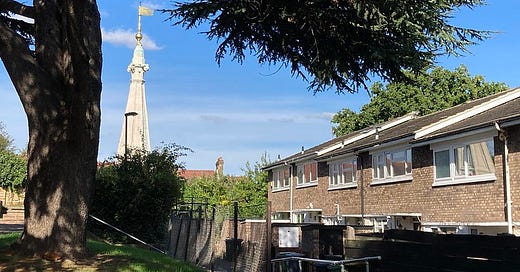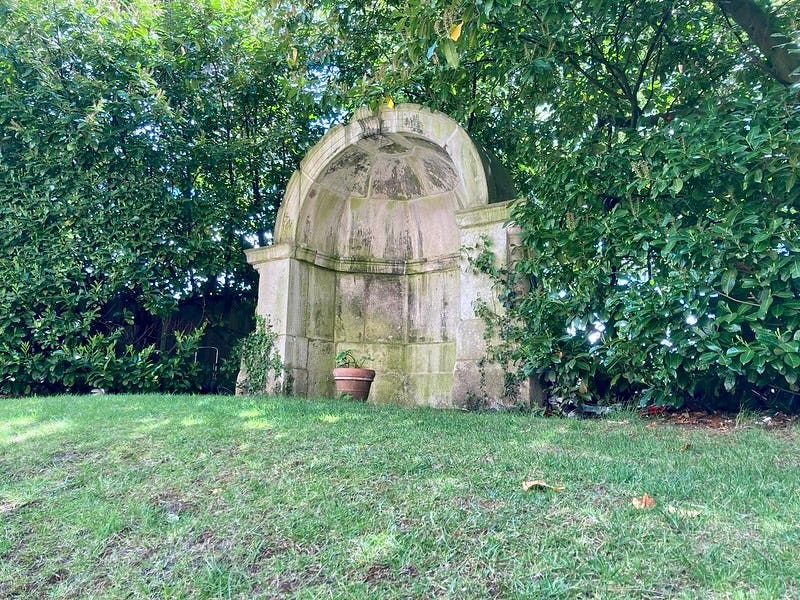Welcome to your Friday newsletter for paying subscribers, with a generous teaser for everyone else.
Imagine opening your curtains in the morning, and the first thing you see is a section of Old London Bridge. That’s the reality for a number of residents on a little-known Richmond housing estate. Other post-war blocks look down on a Christopher Wren spire, or a Henry Moore sculpture, or a Greek temple. In this week’s Londonist: Time Machine, I’ve chosen five unlikely structures hidden on housing estates, and a sixth estate whose secret I unlocked with a packet of Marks and Spencer’s cheese crackers...
That’s for the main section. First, as ever, the History Radar…
History Radar
Upcoming events of interest to fans of London history.
✍️ DESK OF THE WEEK: The desk on which Samuel Johnson penned the Dictionary of the English Language 1755 (or at least, he MIGHT have done) returns to his former home at Gough Square, as the centrepiece of the new Desks, Drudgery and the Dictionary: Samuel Johnson's Garret Lexicography exhibition, which you can visit at no extra cost with the usual entry fee to Dr Johnson's House. It’s open now.
🚣🏽 DOGGETT'S COAT AND BADGE: Yes, it's the name of a pub, but the Doggett's Coat & Badge (9 July) is also an annual boat race taking place on the Thames between London Bridge and Chelsea. It's been going for over 300 years, with up to six young watermen participating each time — here's the course, so you can pick a viewing point.
🇬🇧 YOU BELONG HERE: Southbank Centre’s You Belong Here festival includes a number of events on British history, including an appearance from historian and broadcaster David Olusoga (11 July), and author of Empireland: How Modern Britain is Shaped by its Imperial Past, Sathnam Sanghera (14 July).
💂🏽♀️ BUCKINGHAM PALACE: Take the opportunity to go inside Buckingham Palace at the annual summer opening of the State Rooms, which begins on 11 July. The Throne Room, Ballroom Grand Staircase and Palace Gardens are among the areas open to the public for just a few weeks. Not just for tourists!
🎞️ RELICS OF OLD LONDON: On 11 July, London Metropolitan Archives offers an illustrated talk about photos from the Society of Photographic Relics of Old London's collection. Between 1875 and 1899 the society was commissioned to create a record of 120 buildings under the threat of demolition in a rapidly changing city.
🔎 WOMEN IN INTELLIGENCE: Also on 11 July, historian and biographer Helen Fry is at Stanfords in Battersea Power Station, discussing her new book, Women in Intelligence, which shows how women were central to MI organisations throughout the 20th century.
🌳 BLOOMSBURY GARDENS: The gardens of the Bloomsbury Group are the focus of a special evening at Lambeth's Garden Museum on 12 July. Troy Scott Smith of Sissinghurst Castle, Sara Jackson of Monk’s House, and Hannah Gardner, formerly of Garsington Manor discuss the gardens of Virginia Woolf, Vanessa Bell, Lady Ottoline Morrell, and Vita Sackville-West, to coincide with the museum's current exhibition, Gardening Bohemia: Bloomsbury Women Outdoors.
🛖 LONDON ARCHAEOLOGY: On 13 July, Southwark Cathedral hosts a day of talks about the archaeology of London, with topics ranging from historic graffiti at the Tower of London to the social history of London houses to the evolution of Park Lane from a rural track to a multi-lane traffic hell.
👩🏾🦱 HARLEM IN MAYFAIR: On 14 July, Black History Walks offers a guided tour around Mayfair, focusing on the hidden African and Caribbean history of the posh area, from the 1920s to the 2020s. Hear about Black-owned businesses, Kenyan, South African and Zimbabwean connections, ancient African goddesses, and plenty more.
📍YE OLDE MAPS: Remember last month’s article about a newly released map of medieval London, which charts the Square Mile in the kind of detail never seen before? Well, the article proved so popular that the mapmakers sold out of copies (as well as their Tudor map). I’m now told that they’re fully stocked again. Hoorah!
History Hiding in Housing Estates
Housing estates make up a hefty chunk of London’s built environment. Yet we rarely stray into these spaces, unless we happen to be a resident (or visiting one). That’s a pity, because many have rich histories or unusual architecture, as the wonderful
substack regularly relates. Some hide true historical gems and, in today’s newsletter, I’ve picked out five…1. A bit of Old London Bridge in Richmond
Does this structure look familiar? You might have seen its twin siblings in Victoria Park. Or the one sequestering a statue of Keats in the grounds of Guy’s Hospital. Those three are well-known, but there is a fourth, hiding on a housing estate in East Sheen, Richmond.
All four structures are remnants of Old London Bridge. As you’ll recall, the medieval span was a ramshackle affair, strewn with houses, shops, and a chapel. It looks charming in old paintings, but driving a wagon past all that clutter was a gross botheration. In the 1760s, the buildings were finally torn down to widen the carriageway. To retain some shelter, 14 stone alcoves were built along the bridge. They didn’t last long. The bridge was demolished and rebuilt in the 1820s. Happily, some of the alcoves were saved and moved elsewhere.
The one pictured above can be found round the back of the Courtlands Estate in East Sheen. Two alcoves once stood here, transported over in the 1830s to decorate the grounds of a mansion called Stawell House. Sadly, one of the alcoves was lost when the house was demolished in the 1930s, but the other still lives on for those who would seek it out.
That still leaves nine of the original 14 alcoves unaccounted for. If anyone knows what might have happened to them, I would love to know, in the comments below.
2. A bit of a Wren church in Sydenham
See that pointy pinnacle? It once crowned the church of St Antholin in the Square Mile — one of Christopher Wren’s post-Fire churches, located where today you'll find the hulking Bloomberg building, on Queen Victoria Street.
A violent storm in 1829 badly damaged the spire, so that it had to be taken down. Step forward church warden (and filthy rich printing magnate) Robert Harrild. He rescued the pinnacle and had it transported to his grand home called Round Hill in Sydenham. Meanwhile, the rest of the church was demolished in 1874.
Time moved on. Harrild died. Round Hill was demolished. The Round Hill housing estate grew up in its place. But St Antholin’s spire carried on through it all. It remains there today. Christopher Wren’s most southerly spire is entirely surrounded by 1960s housing, and the occasional mature tree from Harrild’s garden.






